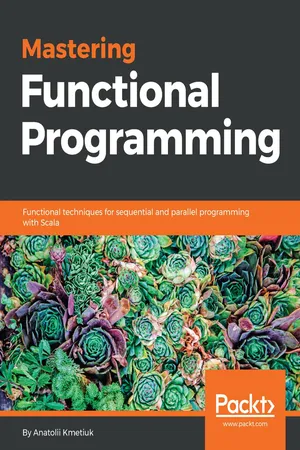
Mastering Functional Programming
Functional techniques for sequential and parallel programming with Scala
- 380 pages
- English
- ePUB (mobile friendly)
- Available on iOS & Android
Mastering Functional Programming
Functional techniques for sequential and parallel programming with Scala
About this book
Learn how functional programming can help you in deploying web servers and working with databases in a declarative and pure way
Key Features
- Learn functional programming from scratch
- Program applications with side effects in a pure way
- Gain expertise in working with array tools for functional programming
Book Description
In large projects, it can get difficult keeping track of all the interdependencies of the code base and how its state changes at runtime. Functional Programming helps us solve these problems. It is a paradigm specifically designed to deal with the complexity of software development. This book will show you how the right abstractions can reduce complexity and make your code easy to read and understand.
Mastering Functional Programming begins by touching upon the basics such as what lambdas are and how to write declarative code with the help of functions. It then moves on to more advanced concepts such as pure functions and type classes, the problems they aim to solve, and how to use them in real-world scenarios. You will also explore some of the more advanced patterns in the world of functional programming, such as monad transformers and Tagless Final. In the concluding chapters, you will be introduced to the actor model, implement it in modern functional languages, and explore the subject of parallel programming.
By the end of the book, you will have mastered the concepts entailing functional programming along with object-oriented programming (OOP) to build robust applications.
What you will learn
- Write reliable and scalable software based on solid foundations
- Explore the cutting edge of computer science research
- Effectively solve complex architectural problems in a robust way
- Avoid unwanted outcomes such as errors or delays and focus on business logic
- Write parallel programs in a functional style using the actor model
- Use functional data structures and collections in your day-to-day work
Who this book is for
If you are from an imperative and OOP background, this book will guide you through the world of functional programming, irrespective of which programming language you use.
Frequently asked questions
- Essential is ideal for learners and professionals who enjoy exploring a wide range of subjects. Access the Essential Library with 800,000+ trusted titles and best-sellers across business, personal growth, and the humanities. Includes unlimited reading time and Standard Read Aloud voice.
- Complete: Perfect for advanced learners and researchers needing full, unrestricted access. Unlock 1.4M+ books across hundreds of subjects, including academic and specialized titles. The Complete Plan also includes advanced features like Premium Read Aloud and Research Assistant.
Please note we cannot support devices running on iOS 13 and Android 7 or earlier. Learn more about using the app.
Information
Libraries for Pure Functional Programming
- The Cats effect
- Server-side programming
Cats effect
- Resource management—think try-with-resources.
- Seamless composition of parallel computations.
- Communication between parallel computations.
ProductR
IO – the concurrence data type
object HelloWorld extends App {
val hello = IO { println("Hello") }
val world = IO { println("World") }
(hello *> world).unsafeRunSync
} Referential transparency
(hello *> world).unsafeRunSync
Inversion of control
Asynchrony with IO
Table of contents
- Title Page
- Copyright and Credits
- Dedication
- Packt Upsell
- Contributors
- Preface
- The Declarative Programming Style
- Functions and Lambdas
- Functional Data Structures
- The Problem of Side Effects
- Effect Types - Abstracting Away Side Effects
- Effect Types in Practice
- The Idea of the Type Classes
- Basic Type Classes and Their Usage
- Libraries for Pure Functional Programming
- Patterns of Advanced Functional Programming
- Introduction to the Actor Model
- The Actor Model in Practice
- Use Case - A Parallel Web Crawler
- Introduction to Scala
- Assessments
- Other Books You May Enjoy